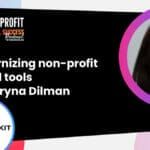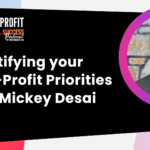Video recording
Audio recording
In today’s episode, we’re thrilled to have a special guest, Douglas Spencer, a leader in the field of branding and marketing. With more than 20 years of experience working with global professionals in various sectors including financial services, healthcare, and non-profits, Douglas brings a wealth of knowledge and insights to our discussion.
Today, we’re going to talk about brand strategy – a crucial factor for the success of any non-profit organization. Douglas will guide us through the process of discovering, shaping, and communicating your unique brand voice. Get ready for an enlightening conversation on how to make your organization stand out and thrive in the non-profit world.
Mentioned Resources
David Pisarek: What is in a brand and why does your non-profit need to care about it? Welcome to the Non-profit Digital Success Podcast. I’m your host, David, and in this episode, we’re going to be talking about brand strategy. And I’ve got Douglas Spencer here with me. Douglas is the President of Spencer Brenneman, LLC, which helps mission-driven organizations reframe their focus, remaster their messages so that they can thrive.
He’s got over 20 years of branding and marketing experience, working with professionals from around the world in verticals such as financial services, health care, and obviously non-profits. And that’s why we’ve got him here today. And he lives in Boston’s South end and is super active in the LGBTQ community there.
Douglas, thank you for taking some time and joining the episode today.
Douglas Spencer: David, thank you for having me. I love any opportunity I can to help non-profits think about their brand, so I love it.
David Pisarek: Fantastic. So tell us, I guess, a little bit about what you do with Spencer Brenneman.
Douglas Spencer: Sure. Well, the challenge that a lot of organizations, not just non-profits face, but a lot of organizations face is that they’re so focused on the day-to-day and they forget about their message because from one day to the next, their focus will change just a slight amount. And before you know it, their focus is pointed in one direction, but they haven’t touched their message, so the message is still going in the other direction. And that’s how messages get out of date.
And it’s really important for organizations, particularly organizations like not-for-profits, that rely on relationships with people outside of their world to always stay on top of their message and always make certain that they are creating authentic, accessible, and memorable messages so people will continue to support them.
And so that’s what we do. We help people take a step back.
We have a process where we help them think about, where are they right now. What is it that the people in their lives really want and need? And how do they do that? How do they do that in a way that is different than all the other options those people have, whether those are prospective employees or those prospective donors, mentors, or anybody?
So that’s what we do, and it’s great. We really love it.
David Pisarek: But basically, what you’re saying, if I’m going to take something away from it, is that a brand is not your logo.
Douglas Spencer: Correct. Oh, absolutely. In fact, we’ve started talking less about branding and more about messaging because the brand is really your message. Well, actually, I define brand as the emotional connection that you have with the people most important to your success.
So again, whether that’s employees, prospective employees, your board, your donors, or corporate sponsors, it’s that connection because people make decisions not just analytically, but mostly emotionally.
Decisions, no matter what decision it is, there’s an emotional element to it.
And oftentimes we make decisions all emotionally, but we use analytics to back them up. For example, I need a car to get from point A to point B, but I want a particular car because of the message it sends. I could say I need a car, but do I need an expensive car? Probably not.
I mean, if there weren’t emotions involved, everyone would be driving a Prius. That’s why the brand is so important.
You’ve got to think about how you’re connecting, again, in an authentic way with the people that are most important to your success. And that’s where the brand and the message come in.
David Pisarek: Yeah. And I think it’s important, obviously, your brand is the visual. So what is the logo, the colours, the font? But what a lot of people don’t think about is the science behind the brand.
I think that’s really what you’re touching on what is the story? What is the message? What is it that you can take and weave through everything and be consistent across the board? And it also comes through in the tone and the style of the writing as well.
Douglas Spencer: Absolutely. I would say the brand isn’t just visual. The brand is also verbal. I like to make the analogy that organizations and their brands have a face and a voice just like humans.
Obviously, you and I look different. People can tell the difference between us. We sound different. They can tell the difference between the sounds of our voices, but the same as with a brand.
So great example is if you look at Apple and Microsoft, go to each of their corporate websites and read what they have to say about diversity, equity and inclusion. And both are fine.
They both say fine things, wonderful things, but the tone of voice is significantly different. And you can tell that those are two different brands. And there’s no reason why the not-for-profit space shouldn’t embrace that, too. Shouldn’t embrace that as a way to differentiate themselves from all the other options people have.
David Pisarek: I think what makes us different also makes us really great and can be empowering and impactful. And being able to go out to the community or the people that you help that you serve and chat with them and explain to them what you do and how you do it, you can have five organizations that feed the homeless.
Each one does something a little bit different. One might be religious-focused, one might be LGBTQ focused, and one might be specifically for children or for seniors. What is the message and how do you differentiate? I think it comes down to this question, why should non-profits care about creating a brand strategy?
Douglas Spencer: Absolutely. Well, there are many reasons that a not-for-profit should think about its brand. So many reasons. And the first one, I think, is this idea about competition. And you have to think very carefully about who else is going after the same dollars that you’re going after.
It may not be someone that does exactly the same thing, but it could be an organization that is adjacent to what you do or is down or upstream from what you do.
For example, we work with many organizations that take care of abused children, but there are other organizations that focus on stopping abuse before it happens.
And so they’re not just competing with other organizations that care for children, they’re competing with people who care about children in general. And so you have to think about how are you different in a way that is relevant from all the other choices that people have.
So competitive differentiation to me, is one of the main reasons why organizations should think carefully about their brand and their message.
And the other reason that it’s very helpful is it helps with employee engagement. It helps with cohesion because if you can articulate if everybody can articulate exactly why the work you do is important and get excited about it and have that be the focus over and over and over every day, it feels great.
It feels like you’re part of something much bigger than yourself. And let’s face it, that’s one of the reasons that people want to work with non-profits, right? Because you know that it takes a village (Thanks, Hillary). And the other reason I think brands are so important is it helps with focus.
So one of the things that we do when we work with our clients is we help them decide what are the three to four things that we do better and differently than all the other options and stick with those things. And so if it doesn’t fit into one of those three to four buckets, they don’t do it.
One woman said to me that working with us gave them permission to say “No” because the great thing about social entrepreneurs or people that are trying to solve a problem is that they really want to solve a problem.
They really want to help. But the bad thing about people like that is that they really want to solve a problem and they really want to help. There’s this idea of wanting to help everyone, wanting to do everything, and it’s just not efficient. And in the long run, it’s just not good for anybody.
So having a brand strategy that really identifies who you are as a brand, who you are as an organization, rather, that helps you stay focused and actually helps you do a better job of whatever it is you do.
David Pisarek: I think there are a few takeaways out of there that I just want to touch on a little bit. I made a couple of notes here as you were chatting.
Douglas Spencer: Yeah, I just jumped in there and I just went “boom, boom, boom”. So I should have paused a little bit. So yeah, let’s dive in.
David Pisarek: Absolutely. So in the ethereal, ultimate grand scheme of things, we’re all here. Every organization or non-profit has a place in this world because you started it from a really genuine and authentic place, or you should have.
A lot of non-profits, community-based groups, and charities, start from a grassroots level. That’s what makes them so impactful and powerful because somebody saw something out there in the community and identified that as something that needs to be fixed or solved. Maybe it was something really obvious, maybe it wasn’t.
That doesn’t really matter. But we’re all here, all the non-profits and businesses and corporations that help in that realm and sphere and consultants.
We’re all here to make the world a better place. In terms of competition, there is, but there isn’t because everybody wants to do their own thing.
But yes, there needs to be a certain point of differentiation that comes in, and that’s what you’re talking about. I think something that a lot of organizations can think about coming out of what you said is, “Yeah, you know what? There is another organization that’s helping with X, Y, or Z. I’m going to call them. I want to talk to their executive director.
What can we do together? How can we partner? How can we bring our causes together, even if it’s just for the holiday season or if it’s for something in the summer or some fundraising barbecue in the town square or a big park in your city or town?”
What can you do to bring other people together and create awareness together about the problem that you’re all trying to solve? And I think that that’s something that could be very powerful.
Douglas Spencer: And another thing, if you want to think about competition or if you want to think rather about differentiation, another benefit of that is you can look at it from the point of view of the donor, of the prospective employee because it will help them decide which organization to support or work for is best for them.
Not every organization is great for every donor and vice versa. So if you’re able to differentiate who you are relative to others, then you’re going to get the people who are most passionate and most appropriate for the work you’re doing and not just someone who at a high level cares about this topic or that topic.
So I think differentiation works both ways, and it’s important for both the non-profit and the people who support them.
David Pisarek: Catching on that, I think something that we’re skirting around, but we’re not actually seeing right now is, and this probably is part of your package and your service offering that you do is talking about personas and avatars.
And who is your ideal… In the business world, we say your ideal customer. But in the non-profit world, who’s your ideal donor? Who’s your ideal participant in your program? Who’s the ideal corporate sponsor? Talk about demographic and geographic.
Everybody always thinks about that when you start thinking about personas. But what is their psychographic? That is something that really digs in. What does this person, this ideal person, this Avatar, A, B, C, D, however many you have, what do they care about?
Where do they spend their free time? What makes them tick? And if you could touch on those emotional elements, it will help you be more in the forefront of their mind as they think about, “Okay, yeah, you know what? End-of-year donation. I want to donate to a cause that helps do this”. And hopefully, you come to mind.
Douglas Spencer: Absolutely. And we also work with folks, we call it the ways, the way your brand comes to life, but it’s also known as the brand attributes.
And so organizations can have a whole lot of different attributes, and it will appeal to… Some people would rather give money or support organizations that are very scholarly, and have a very academic focus, and some want a really grassroots and almost guerrilla mentality. And so your message has to bring those to life.
I think a great example of those is if you look at Greenpeace and you look at the Nature Conservancy, those are two organizations that at the end of the day, they have the same goal.
They want to save the planet. But the tone that they use, and the personality of that of their organization aligns with two different types of donors. Two different types of donors, ones that are like, “Yeah, we can do this. And one’s like”, “Yeah, we got to do this”.
And that’s a great example of what you’re saying that you have to understand what motivates the people that you want to reach. Where do you fit into their life? Where do you fit into their desire to make the world a better place?
David Pisarek: Absolutely. And just further to that, the question that I have for you is how can organizations use their messaging and their brand strategies to stay focused on their core, I’m going to call it a core value, but their main purpose?
Douglas Spencer: Okay. Yeah. I think they really just have to get crystal clear and articulate.
What is it that you do at the highest level? What is it you do without getting into details? And then you talk about how you do it. Underneath that, you also have to be crystal clear on why you do this. Why do you believe that your work is important in the world? And so you have to get crystal clear on all of those things.
And the way to do that is you got to ask questions.
You got to ask questions of yourself, of your board. You’ve got to ask questions of your volunteers, your employees, your donors, anybody that funds you, anybody that supports you, and sometimes even your elected officials, and try to get a sense of what’s important to them.
And then the idea is to find the match between what you do best relative to what is needed most based on the conversations that you’ve had with the people most important to your success. So what do you do best relative to what is needed most?
David Pisarek: And that’s what’s going to help you define what you do and how you speak to the world about what it is that you do. If people care about this, but you’re over here doing this, it’s going to be really hard to bridge that gap and get them to go, “Okay, you know what? Douglas’s organization, I absolutely need to support them”.
But if you’re doing something very different or you’re not speaking in the right tone or the right style, or even, dare I say, publishing your content where they’re actually hanging out? You’re not going to be able to connect with them.
Douglas Spencer: No, not at all. I see so many times organizations that don’t have that focus, and they veer away from their original mission without any discussion, without any buy-in from the community.
There’s one here in Boston that is really struggling because they’ve lost their way. They’ve got some new things that they’re trying to do, but they’ve forgotten where they started.
I think that it’s really important to stay focused on who you are, what you can do best, and what’s needed most.
David Pisarek: Absolutely. I think that’s really key for sure. If anybody missed that, rewind about 15 seconds and replay that. I think what we’re talking about messaging, there’s all the stuff that goes out into the public, whether it’s direct mail, emails, website, advertising campaigns, door-to-door solicitation, all that stuff. What often I think is like the long lost cousin is internal comms.
Douglas Spencer: Amen.
David Pisarek: How do you speak to your staff? How do you rally the troops and get them to buy in and understand, “Okay, this is the direction you’re headed in”. Why do you think internal comms is so important to driving an organization’s message and mission forward?
Douglas Spencer: I do. I truly do. I get so excited when I think about internal comms. The first reason is that there is no such thing as internal only because… And it’s not just talking about information or top-secret stuff, I’m talking about just how you talk. Because think about everything that you say throughout the course of the day.
Language is contagious. We pick up phrases, words, and intonations from each other, from popular culture, and from our significant others, and we integrate them without even thinking about it.
So you can harness that power. You can harness the fact that language is contagious by having a particular way that you or the same messages that you repeat over and over again internally. But again, they have to be authentic. It’s a word I use a lot, and it might sound a little cliché, but it’s true. It has to be authentic.
And if you can get everyone on the inside talking the same way, they will, of course, talk the same way when they’re talking to people outside the organization.
So internal comms is really important. And it’s also important for that focus element that we talked about because if you are continually reiterating why what you do is important, and if you’re continually reiterating how you do it differently and better than anybody else, that’s going to keep people focused on that.
Doing that internally is crucial because it’s not just the executive director that’s saying, do this, do this, do this. It’s everybody that has to remember that. If you work at a health center, the person who greets you and takes… (I don’t know, you’re in Canada, so you don’t have health care issues like we do in the United States -laughs-). They have to be able to understand why they’re there.
They have to understand if they’re an academic organization or if they’re a grassroots organization. I think that’s the example I used. They have to understand that, too.
And so internal comms is such a powerful tool to get people on the same page, to get your message out externally as well, and also to keep people happy and engaged and really behind what you’re doing.
David Pisarek: Absolutely. People are your brand because every organization has people, even if you’re a team of one. You go out, you’re at a dinner party, you’re at a birthday party for your best friend or family member or something like that.
Or if you have a child, you’re taking them to their friend’s birthday party or standing around, you’re talking with other adults. “What do you do?” You have conversations with people out there in the real world. I think to your point, being authentic and having a really clear goal for your organization that is tied to something very specific.
Create the empathy that people need to care about the work you do and will help associate your brand, so your organization’s name in this case, with whatever it is that you’re trying to do, like fighting cancer or helping feed the homeless or pet shelter or whatever it happens to be.
Douglas Spencer: And you touched on something that I also want to draw attention to, and that’s the idea of consistency. So consistency is so important.
So the other great thing about internal communications is, and actually just any messaging strategy in general, is if everybody is out at different birthday parties or soccer games, everybody in your organization is out at those events and they’re saying the same thing, then it’s going to be a lot more believable.
It’s going to be a lot more compelling. It’s going to be a lot more memorable. So consistency and how you talk about what you do is critical. And internal comms is a great way to boost that.
David Pisarek: So part of this, I think, comes down to most organizations, they have a mission vision values statement or series of statements.
I think it really comes down to the organization from the top down. When this is the direction we’re going in, here’s how we need to speak, bring your team together or teams together or three people have a conversation around what is the message going forward from this point forward.
The consistency is not just for a month, it’s not just for two months. It’s in perpetuity until there’s a decision by the board or executive director or the president or a need in the community to shift that.
You need to follow through and be consistent over and over and over again.
Douglas Spencer: Absolutely. I think the board is a really good point. It’s really important for the board to be on the same page. Oftentimes, boards, just don’t really get it. They just think, Yeah, well, we don’t… That’s fine. It’s not as important as it is, but it’s truly important.
One of the things that I’ve been shocked to learn over the years is how disengaged many board members are and how many of them really can’t say in a concise, compelling, and memorable way what the organization does. The board has to really believe in the organization, in its mission, and what it does and what it doesn’t do.
The board has got to be there because executive directors come and go. When I was in the for-profit sector, I worked at corporations where every time we got a new CEO, they would want to make sure they had their imprint on the brand. But for a not-for-profit, you can’t do that.
You don’t have the resources to do that. You don’t have the people to do that, typically. The board’s really got to take the lead in establishing who the organization is as a brand so that when an executive director moves on or retires or whatever, then you still have that consistency.
Douglas Spencer: So board involvement in the brand is crucial. It doesn’t happen nearly enough.
David Pisarek: I think having the inside on side, I say that on and off all the time, but you want to bring the inside on side, get everybody speaking the same speak and talking the same talk and walking the same walk and making sure that the consistency is there from person to person because everybody goes out in the real world.
But I think to that point, if you have a really clear focus for your mission and your organization, if you needed to hire a new VP or CEO or new employee to help clean or whatever it happens to be, if you are really clear on what your purpose is, I think that it helps, at least anecdotally, attract people that care about the cause inherently. So how can, Douglas, from your perspective, how can a brand strategy support attract and retaining really solid talent?
Douglas Spencer: Absolutely. It goes back to what we were talking about before when I mentioned the donors, finding the donors that are right for you. Same with prospective employees and leaders. If you are crystal clear on who you are and the work you’re doing, then it’s going to be easier to weed out the folks that just want a job.
Because let’s face it, a lot of mission-driven organizations don’t pay as well as perhaps some for-profit organizations. And so it’s got to be that mission that compels people. It’s got to be the way they talk about it, and it’s got to be the way people inside the organization talk about it.
Because the worst thing you could do, well, not the worst thing, but one of the worst things you could do is have employees just saying the same thing or having everybody say the same thing over again and just spitting it out and not meaning it and not feeling it.
If you’ve got an organization where everybody feels the same thing, is excited about the same thing, and talks about it the same way, then you’re going to find the people that want to be one of those people.
You’re going to find the people that want to be a part of your journey and your mission. And if you can’t do it, you’re going to find people that are hoping maybe this organization is right for them or they don’t care, they’ll just take a job and nobody wants that. So being able to use your brand to get people on the inside excited so that people on the outside want to join you, that’s so powerful.
David Pisarek: Absolutely. Just a little disclaimer, not every employee you hire is going to be a top-notch talent. Hopefully, you get people that really care about the organization.
This isn’t going to solve all of your hiring needs by saying, Okay, this is what we’re doing. But I think it certainly helps. It will help set you apart and help set you up for more success than if you had not done it.
Douglas Spencer: Absolutely.
David Pisarek: In short, your brand is not your logo. It is not your colour. It is not your message. It is not the name of your organization. It is not how people speak about you or how your employees speak about your organization or what the board or CEO says. It’s a combination of all of it. You’ve got to bring it all together. That’s where the strategy piece comes in.
Douglas Spencer: Amen. Absolutely.
David Pisarek: Douglas, these have been some amazing insights around brand strategy. I hope people listening to this have been able to get some great advice from you and from the conversation that we’ve had.
I want to challenge everybody. I like to put a challenge in every episode. I like it. But I want to challenge everybody to talk to your senior leadership. It could be your direct manager if you’re not comfortable going to VP or executive CEO level or anything like that but talk about brand strategy.
Go to your website, and take a look at it as an outsider. What is our message? What is it that we’re doing? And see if you can figure that out. So with that, if anybody wants to get in touch with you, Douglas, what do they need to do?
Douglas Spencer: Well, I’m easily found on LinkedIn, Douglas Spencer. You can go to our website, which is spencerbrenneman.com, you can also go to the Vanity Wells website of message.builders/abc. That goes right to the methodology that we use: Ask, Build, and Connect.
And yeah, I’m happy to talk to anybody and hear their stories. I would love to hear how people have been using their messaging strategy or their branding strategy to meet all of those goals. So yeah, hit me up. Let’s talk.
David Pisarek: Awesome. And rumour has it that you’ve got a white paper.
Douglas Spencer: I do. You’re right. We have a white paper. It’s called “Lessons Learned From the For-Profit Sector”, what non-profits can learn from for-profits. We also have a flip side. We also have one that says “For-profits can learn from non-profits”. Those are available at message.builders/whitepapers.
David Pisarek: Thanks so much again for joining in, Douglas. It’s been great having you on the non-profit Digital Success Podcast. For everybody listening, hopefully, there’s a whole bunch of you. If you want any of the links or resources that Douglas provided, head over to our podcast page at nonprofitdigitalsuccess.com. Click on this episode. We’ve got the show notes there. We’ll have links to everything and all the details. And until next time, keep on being successful.














0 Comments